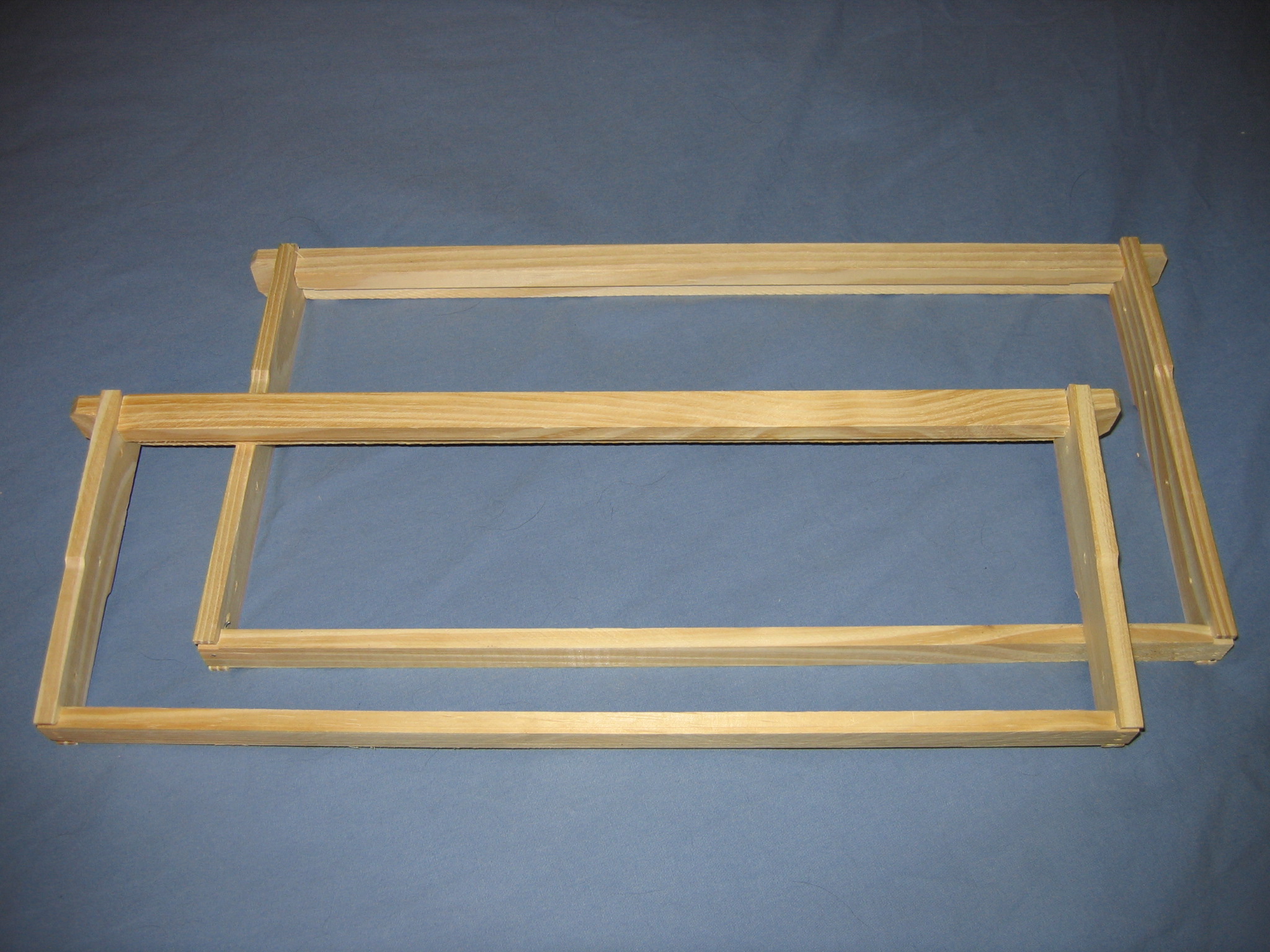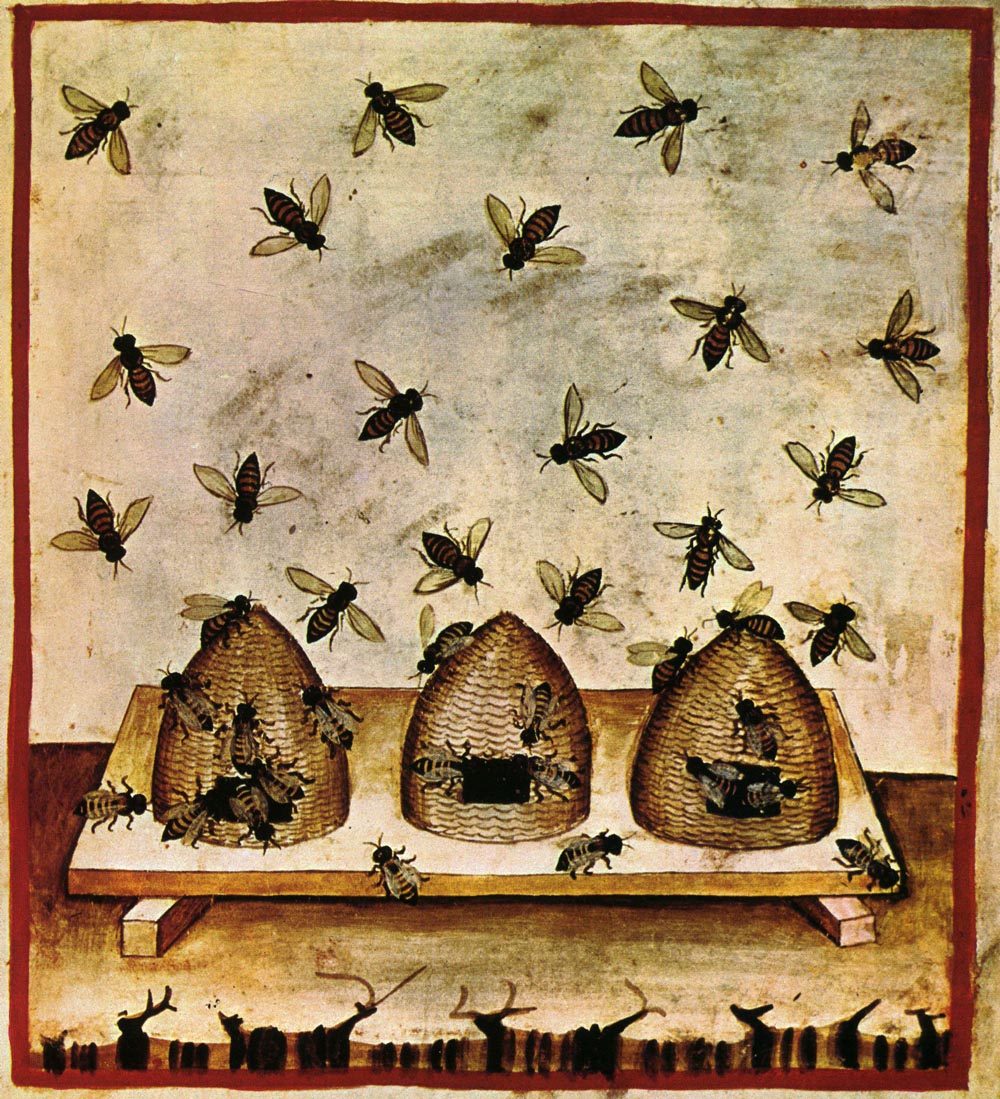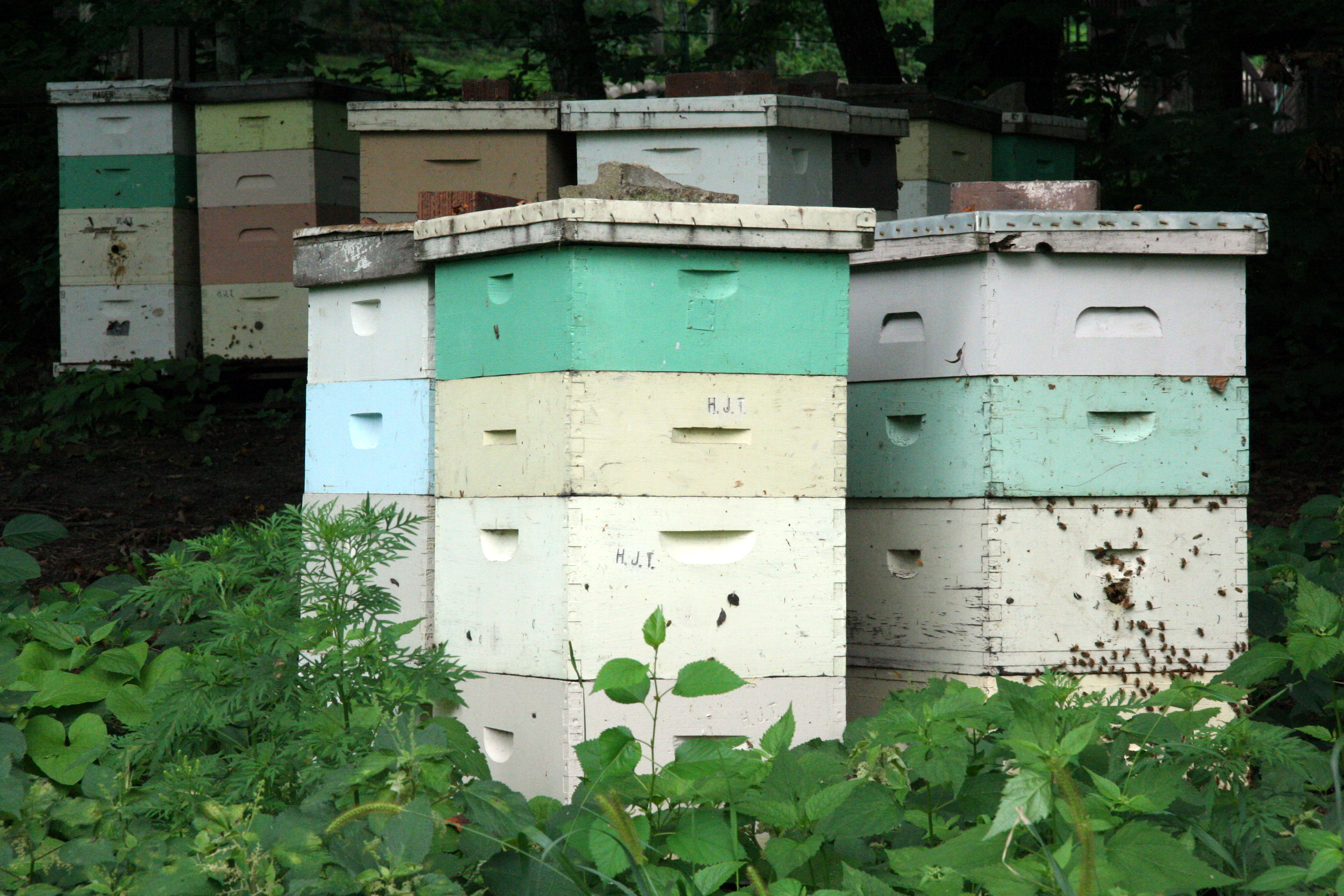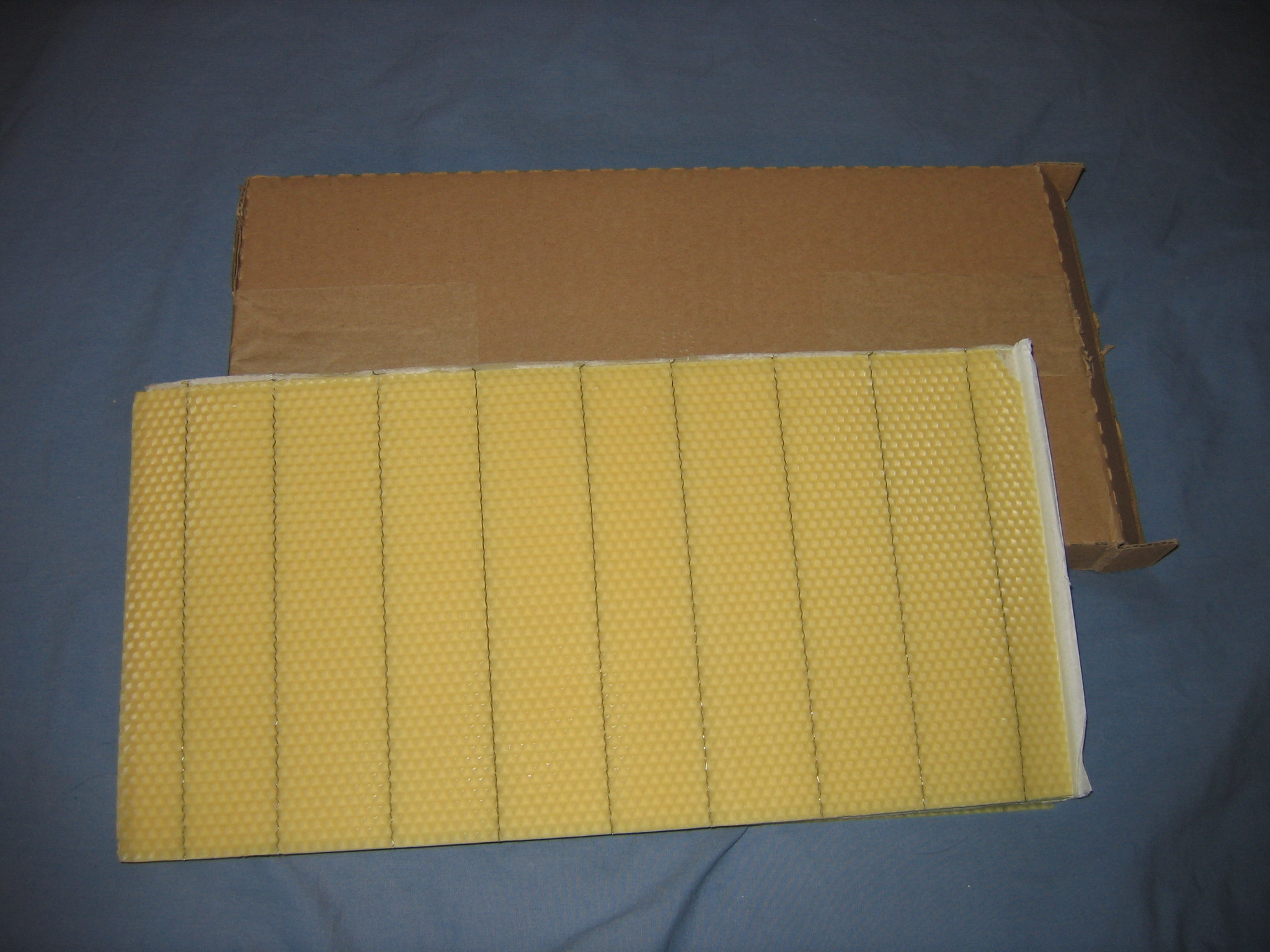|
Frame (beehive)
A hive frame or honey frame is a structural element in a beehive that holds the honeycomb or brood comb within the hive enclosure or box. The hive frame is a key part of the modern movable-comb hive. It can be removed in order to inspect the bees for disease or to extract the excess honey. History In 1814 Petro Prokopovych invented the world's first beehive which used hive frames. Early prototypes had a large distance between frames, and the frame lay on supporting strips of wood. As a result, the frames were cross-attached by burr comb and propolized to the supporting strips and were difficult to remove. In Prokopovych's design, the frames were placed only in the honey chamber. In the brood chamber, the bees built the combs in free style. Johann Dzierzon described the correct distance between combs in the brood chamber as 1½ inches from the center of one bar to the center of the next. In 1848, Dzierzon introduced grooves into the hive's side walls replacing the strips of wood t ... [...More Info...] [...Related Items...] OR: [Wikipedia] [Google] [Baidu] |
Wax Foundation
Wax foundation or honeycomb base is a plate made of wax forming the base of one honeycomb. It is used in beekeeping to give the bees a foundation on which they can build the honeycomb. Wax foundation is considered one of the most important inventions in modern beekeeping. History Wax foundation was invented by German Johannes Mehring in 1857, a few years after Langstroth designed and patented the Langstroth hive on October 5, 1852. Mehring's wax foundation had only the bottom of the cells, and today's base with the foundation of the cells was invented by US beekeeper Samuel Wagner. The Langstroth patent did not call for foundation and let the bees build their own comb. At first, wax foundations were made in the wax foundation press. The first presses were made of wood, while later presses could be made of plaster, cement, and finally metal, which are the ones used today. Wagner also invented the wax foundation rollers, but never perfected them; the first usable rollers were made ... [...More Info...] [...Related Items...] OR: [Wikipedia] [Google] [Baidu] |
BS National Beehive
The Improved National Beehive was a form of Langstroth beehive standardized by two British Standards (in 1946 and then in 1960, before being withdrawn in 1984). The same standard contained the specification of the Smith beehive: these two forms represent the most popular designs used in the UK. Design The National hive, as it usually known, is based on Langstroth hive design principles: a vertical stack of modular components. Its dimensions are generally smaller and notably the brood chamber is shallower than the typical Langstroth hive to suit a less prolific bee strain. The original specification and the associated Ministry of Agriculture, Fisheries and Food leaflet detail a floor (now often superseded by an open-mesh floor which allows monitoring of Varroa infestation), stand, deeper standard brood boxes, shallower honey ''Super'' boxes, a section rack (for production of sections of comb honey Comb honey is honey intended for consumption by humans, which is still contained ... [...More Info...] [...Related Items...] OR: [Wikipedia] [Google] [Baidu] |
Buildings And Structures Used To Confine Animals
A building, or edifice, is an enclosed structure with a roof and walls standing more or less permanently in one place, such as a house or factory (although there's also portable buildings). Buildings come in a variety of sizes, shapes, and functions, and have been adapted throughout history for a wide number of factors, from building materials available, to weather conditions, land prices, ground conditions, specific uses, prestige, and aesthetic reasons. To better understand the term ''building'' compare the list of nonbuilding structures. Buildings serve several societal needs – primarily as shelter from weather, security, living space, privacy, to store belongings, and to comfortably live and work. A building as a shelter represents a physical division of the human habitat (a place of comfort and safety) and the ''outside'' (a place that at times may be harsh and harmful). Ever since the first cave paintings, buildings have also become objects or canvasses of much artisti ... [...More Info...] [...Related Items...] OR: [Wikipedia] [Google] [Baidu] |
Beekeeping Tools
Beekeeping (or apiculture) is the maintenance of bee colonies, commonly in man-made beehives. Honey bees in the genus '' Apis'' are the most-commonly-kept species but other honey-producing bees such as ''Melipona'' stingless bees are also kept. Beekeepers (or apiarists) keep bees to collect honey and other products of the hive: beeswax, propolis, bee pollen, and royal jelly. Pollination of crops, raising queens, and production of package bees for sale are other sources of beekeeping income. Bee hives are kept in an apiary or "bee yard". The keeping of bees by humans, primarily for honey production, began around 10,000 years ago. Georgia is known as the "cradle of beekeeping" and the oldest honey ever found comes from that country. The 5,500-year-old honey was unearthed from the grave of a noblewoman during archaeological excavations in 2003 near the town Borjomi. Ceramic jars found in the grave contained several types of honey, including linden and flower honey. Domestication of ... [...More Info...] [...Related Items...] OR: [Wikipedia] [Google] [Baidu] |
Charles Dadant
Charles Dadant (20 May 1817 – 26 July 1902) was a French-American beekeeper. Along with Petro Prokopovych, Dadant is considered one of the founding fathers of modern beekeeping. Biography Dadant was born in Vaux-sous-Aubigny, in Haute-Marne, in the Champagne-Ardenne region of France. In 1863, at age forty-six, he moved to America, with dreams of starting a vineyard. Dadant purchased land on the rolling tallgrass prairie in Hamilton, western Illinois, where he built a simple log house. After paying for his family to come to America from France and buying a farm, he was penniless. He did not know a word of English, but he was determined to succeed in his new country. When his dreams of being a vintner were not fulfilled, he turned to beekeeping, a hobby he had learned in France. Dadant learned English by subscribing to the ''New York Tribune''. While working as a traveling salesman in France he educated himself. As his horse would plod along, Dadant would read the works of the ... [...More Info...] [...Related Items...] OR: [Wikipedia] [Google] [Baidu] |
Buckfast Bee
The Buckfast bee is a breed of honey bee, a cross of many subspecies and their strains, developed by Brother Adam (born Karl Kehrle in 1898 in Germany), who was in charge of beekeeping from 1919 at Buckfast Abbey in Devon in the United Kingdom. Breeding of the Buckfast bee is now done by breeders throughout Europe belonging to the ''Federation of European Buckfast Beekeepers'' (G.D.E.B.). This organization maintains a pedigree for Buckfast bees, originating from the time of Brother Adam. In 1916, only 16 surviving colonies were left in the abbey. All of them were either pure Ligurian (Italian) or of Ligurian origin, hybrids between Ligurian and the English black bee '' A. m. mellifera''. Brother Adam also imported some more Italian queens. From these, he began to develop what would come to be known as the Buckfast bee. Origin and Heritage According to Brother Adam's personal notes, 1915 was "The last season colonies of the former native honeybee (the British strain of ''A. m ... [...More Info...] [...Related Items...] OR: [Wikipedia] [Google] [Baidu] |
Beehive
A beehive is an enclosed structure in which some honey bee species of the subgenus '' Apis'' live and raise their young. Though the word ''beehive'' is commonly used to describe the nest of any bee colony, scientific and professional literature distinguishes ''nest'' from ''hive''. ''Nest'' is used to discuss colonies that house themselves in natural or artificial cavities or are hanging and exposed. ''Hive'' is used to describe an artificial/man-made structure to house a honey bee nest. Several species of ''Apis'' live in colonies, but for honey production the western honey bee (''Apis mellifera'') and the eastern honey bee (''Apis cerana'') are the main species kept in hives. The nest's internal structure is a densely packed group of hexagonal prismatic cells made of beeswax, called a honeycomb. The bees use the cells to store food (honey and pollen) and to house the brood (eggs, larvae, and pupae). Beehives serve several purposes: production of honey, pollination of nearby ... [...More Info...] [...Related Items...] OR: [Wikipedia] [Google] [Baidu] |
Varroa Destructor
''Varroa destructor'', the ''Varroa'' mite is an ectoparasite, external parasitic mite that attacks and feeds on the honey bees ''Apis cerana'' and ''Apis mellifera''. The disease caused by the mites is called varroosis. The ''Varroa'' mite can reproduce only in a honey bee colony. It attaches to the body of the bee and weakens the bee by sucking fat body, fat bodies. The species is a vector for at least five debilitating bee viruses, including RNA viruses such as the deformed wing virus (DWV). A significant mite infestation leads to the death of a honey bee colony, usually in the late autumn through early spring. The ''Varroa'' mite is the parasite with possibly the most pronounced economic impact on the beekeeping industry. ''Varroa'' is considered to be one of multiple stress factors contributing to the higher levels of bee losses around the world. Physical description File:Varroa destructor protonymph (5048063601).jpg, ''V. destructor'' protonymph File:Varroa destructor deu ... [...More Info...] [...Related Items...] OR: [Wikipedia] [Google] [Baidu] |
Queen Bee
A queen bee is typically an adult, mated female (gyne) that lives in a colony or hive of honey bees. With fully developed reproductive organs, the queen is usually the mother of most, if not all, of the bees in the beehive. Queens are developed from larvae selected by worker bees and specially fed in order to become sexually mature. There is normally only one adult, mated queen in a hive, in which case the bees will usually follow and fiercely protect her. The term "queen bee" can be more generally applied to any dominant reproductive female in a colony of a eusocial bee species other than honey bees. However, as in the Brazilian stingless bee ''Schwarziana quadripunctata'', a single nest may have multiple queens or even dwarf queens, ready to replace a dominant queen in a case of sudden death. Development During the warm parts of the year, female "worker" bees leave the hive every day to collect nectar and pollen. While male bees serve no architectural or pollinating purpo ... [...More Info...] [...Related Items...] OR: [Wikipedia] [Google] [Baidu] |
Injection Moulding
Injection moulding (U.S. spelling: injection molding) is a manufacturing process for producing parts by injecting molten material into a mould, or mold. Injection moulding can be performed with a host of materials mainly including metals (for which the process is called die-casting), glasses, elastomers, confections, and most commonly thermoplastic and thermosetting polymers. Material for the part is fed into a heated barrel, mixed (using a helical screw), and injected into a mould cavity, where it cools and hardens to the configuration of the cavity. After a product is designed, usually by an industrial designer or an engineer, moulds are made by a mould-maker (or toolmaker) from metal, usually either steel or aluminium, and precision-machined to form the features of the desired part. Injection moulding is widely used for manufacturing a variety of parts, from the smallest components to entire body panels of cars. Advances in 3D printing technology, using photopolymers that ... [...More Info...] [...Related Items...] OR: [Wikipedia] [Google] [Baidu] |
Frame From Hive Of Honey Bee (apis Mellifera)
A frame is often a structural system that supports other components of a physical construction and/or steel frame that limits the construction's extent. Frame and FRAME may also refer to: Physical objects In building construction *Framing (construction), a building term known as light frame construction *Framer, a carpenter who assembles major structural elements in constructing a building *A-frame, a basic structure designed to bear a load in a lightweight economical manner **A-frame house, a house following the same principle *Door frame or window frame, fixed structures to which the hinges of doors or windows are attached *Frame and panel, a method of woodworking *Space frame, a method of construction using lightweight or light materials *Timber framing, a method of building for creating framed structures of heavy timber or willow wood In vehicles *Frame (aircraft), structural rings in an aircraft fuselage *Frame (nautical), the skeleton of a boat *Bicycle frame, the main c ... [...More Info...] [...Related Items...] OR: [Wikipedia] [Google] [Baidu] |
Wax Foundation
Wax foundation or honeycomb base is a plate made of wax forming the base of one honeycomb. It is used in beekeeping to give the bees a foundation on which they can build the honeycomb. Wax foundation is considered one of the most important inventions in modern beekeeping. History Wax foundation was invented by German Johannes Mehring in 1857, a few years after Langstroth designed and patented the Langstroth hive on October 5, 1852. Mehring's wax foundation had only the bottom of the cells, and today's base with the foundation of the cells was invented by US beekeeper Samuel Wagner. The Langstroth patent did not call for foundation and let the bees build their own comb. At first, wax foundations were made in the wax foundation press. The first presses were made of wood, while later presses could be made of plaster, cement, and finally metal, which are the ones used today. Wagner also invented the wax foundation rollers, but never perfected them; the first usable rollers were made ... [...More Info...] [...Related Items...] OR: [Wikipedia] [Google] [Baidu] |


.jpg)





